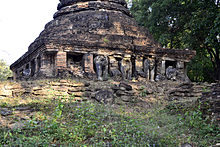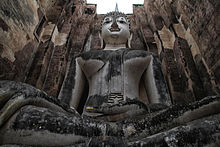Sukhothai Historical Park
This article needs additional citations for verification. (December 2018) |
acres; 27 mi2 | |
|---|---|
| Coordinates | 17°01′16″N 99°42′13″E / 17.02111°N 99.70361°E |
Sukhothai Historical Park (
The city's walls form a rectangle about 2 km (1.2 mi) east-west by 1.6 km (0.99 mi) north-south. There are 193 ruins on 70 km2 (27 sq mi) of land. There is a gate in the centre of each wall. Inside are the remains of the royal palace and twenty-six temples, the largest being Wat Mahathat. The park is maintained by the Fine Arts Department of Thailand with help from UNESCO, which has declared it a World Heritage Site. Each year, the park welcomes thousands of visitors.
History
Khmer Era
Originally, Sukhothai was a Khmer empire's outpost named Sukhodaya.[2][3][4] During the reign of Khmer Empire, the Khmers built some monuments there, several of them survived in Sukhothai Historical Park such as the Ta Pha Daeng shrine, Wat Phra Phai Luang, and Wat Sisawai.[5] About some 50 kilometer north of Sukhothai is another Khmer military outpost of Si Satchanalai or Sri Sajanalaya.[6][7]
In the mid-13th century, the Tai tribes led by Si Indradit rebelled against the Khmer governor at Sukhodaya and established Sukhothai as an independent Tai state and remained the center of Tai power until the end of the fourteenth century.[2][7]
Liberation from Khmer Empire (Lavo)

Prior to the 13th century, a succession of
Modern historians believe that the secession of Sukhothai (once known as Sukhodaya) from the Khmer empire began as early as 1180 during the reign of Pho Khun Sri Naw Namthom who was the ruler of Sukhothai and the peripheral city of Sri Satchanalai (modern day
Two brothers, Pho Khun Bangklanghao and Pho Khun
Traditional Thai historians considered the founding of the Sukhothai Kingdom as the beginning of the Thai nation because little was known about the kingdoms prior to Sukhothai. Modern historical studies demonstrate that Thai history began before Sukhothai. Yet the foundation of Sukhothai is still a celebrated event.
Expansions under Ramkamhaeng

To the west, Ramkhamhaeng helped the Mons under
With regard to culture, Ramkhamhaeng had the monks from Sri Thamnakorn propagate the Theravada religion in Sukhothai. In 1283, Ramkamhaeng is said to have invented
It was also during this period that the first contacts with Yuan dynasty were established and Sukhothai began sending trade missions to China. One well-known export of Sukhothai was the Sangkalok (Song dynasty pottery). This was the only period that Siam produced Chinese-styled ceramics, which fell out of use by the 14th century.
Decline and domination of Ayutthaya
Sukhothai domination was short-lived. After the death of Ramkhamhaeng in 1298, Sukhothai's tributaries broke away. Ramkhamhaeng was succeeded by his son,
Later Development

Sukhothai repopulated again but declined due to successive
In 1907,
In July 1988 the historical park was officially opened. On 12 December 1991, it was declared a World Heritage Site as part of the Historic Town of Sukhothai and Associated Historic Towns together with the associated historical parks in Kamphaeng Phet and Si Satchanalai.
Management
Sukhothai Historical Park is managed by the Fine Arts Department, Ministry of Culture. The protection of the area was first announced in the Royal Gazette on 6 June 1962.[10] The enabling law is the Act on Ancient Monuments, Antiques, Objects of Art and National Museums, B.E. 2504 (1961) as amended by Act (No. 2), B.E. 2535 (1992).

- King Ramkhamhaeng Monument
- Wat Mahāthāt
- Ramkhamhaeng National Museum
- Wat Traphang Ngoen
- Wat Sri Sawai (Wat Sri Svāya)
- Wat Traphang Thong
- Wat Sra Sri (Wat Sa Si)
- Wat Chana Songkhrām
- Wat Trakuan
- San Ta Pha Daeng (Ta Pha Daeng Shrine)
- Wat Phra Phai Luang
- Turiang Kilns
- Wat Sangkhawat (Wat Sanghāvāsa)
- Wat Si Chum
- Wat Chang Lom
- Wat Thraphang Thong Lang
- Wat Chedi Sung
- Wat Kon Laeng
- Wat Ton Chan
- Wat Chetuphon
- Wat Chedi Si Hong
- Wat Si Phichit Kirati Kanlayaram (Sri Vicitrakirtikanlyārāma)
- Wat Wihan Thong,
- Wat Asokaram
- Wat Mum Langka
- Wat Saphan Hin
- Wat Aranyik (Wat Arannika)
- Wat Chang Rop
- Wat Chedi Ngam
- Wat Tham Hip
- Wat Mangkon
- Wat Phra Yuen
- Wat Pa Mamuang
- Wat Thuek
- Phra Ruang Dam
Sights
Wat Mahathat

Wat Mahathat or Mahathat Temple (
Noen Prasat

Noen Prasat or Palace Hill (
Ramkhamhaeng National Museum

Ramkhamhaeng National Museum (
Wat Si Sawai

Wat Si Sawai or Si Sawai Temple (
Wat Phra Phai Luang

Wat Phra Phai Luang (
Wat Sa Si

Wat Sa Si (
Wat Asokaram
Wat Asokārām (
Wat Tra Kuan

Wat Tra Kuan (
Wat Chana Songkhram

Wat Chana Songkhram (
Wat Pa Mamuang

Wat Pa Mamuang or Pa Mamuang Temple (
Wat Chang Lom

Wat Chang Lom (
Wat Chang Rop

Wat Chang Rop (also "Rob") (
Wat Si Chum

Wat Si Chum (
Wat Saphan Hin

Wat Saphan Hin (
Wat Aranyik

Wat Aranyik (
Wat Chedi Ngam

Wat Chedi Ngam (Thai: วัดเจดีย์งาม) is a temple located about 2.5 kilometers west of the western city wall. The main building of Wat Chedi Ngam are aligned in east–west direction. There is a paved road leads up to the temple. The bell-shaped stupa is in Sri Lanka style which is visible from afar. Similar to Wat Chang Rop, the stupa stands on a large, square base of 24 meters on each side. On each side there is a niche which once contained a statue of Buddha. There is a slate tiles floor vihara in the east but few remains are still visible. In the north there are some structures of brick and stone that might once were monk residence. In the vicinity there is a fountain.
Wat Chedi Si Hong

Wat Chedi Si Hong (
Wat Chetuphon

Wat Chetuphon (Thai: วัดเชตุพล) is a temple located about two kilometers south of the southern city wall, which surrounds the historic city of Sukhothai. According to Wat Sorasak Inscription, the temple have been built before 1412 and was restored in 1970-1972 by the Fine Arts Department. A moat and a brick wall surround this temple and in the center stands a large brick mandapa, at the four outer sides they are 14th or early 15th century stucco Buddha sculptures with different postures. The eastern side depicts a walking Buddha, the northern one is sitting, the western one is standing, and the southern one is a reclining Buddha. The two large statues in the west and in the east are called "Phra Attharot". Another special feature of this temple is the use of slate in the galleries around the mandapa and the door frame. To the west, there is a slightly smaller mandapa with a Buddha image, which is called by the locals "Phra Sri Ariya" (
Wat Traphang Ngoen

Wat Traphang Ngoen (
Wat Traphang Thong

Wat Traphang Thong (
Wat Tuek

Wat Tuek (Thai: วัดตึก) lies approximately 400 meters west of the O Gate (Thai: ประตูอ้อ) outside the old Sukhothai. This temple was founded in the time of Sukhothai Kingdom. In 1970 to 1971 the temple was restored by the Fine Arts Department. On the small temple grounds there is a small mandapa with a side length of eight meters contains a seated Buddha statue made of bricks that was once covered with stucco. The mandapa has three brick walls and a porch on the east side which is similar to Wat Si Chum, but is much smaller scale. There was a stucco reliefs on the outer sides, which can be seen on historical photos depicting scenes the life of Buddha. East of mandapa are the remains of a vihara with dimensions of 10 × 14 meters with some laterite pillars and a greatly dilapidated Buddha image made of laterite. The vihara is surrounded by several smaller stupa bases.
Wat Sorasak

Wat Sorasak (
Thuriang Kilns
The Thuriang Kilns (Thai: เตาทุเรียง) are ruins of the old celadon factory, which may have been founded in the late 13th century, are situated near the city moat near Wat Phra Phai Luang. This is a site where Sukhothai celadons were made. So far, 49 kilns have been discovered in 3 different areas: 37 lie north of the moat, 9 to the south, near the city wall, and 3 to the east. The vaulted brick kilns measure 1.5 – 2 metres wide and 4.5 metres long. The ceramic wares found here are generally large bowls and jars; they have a matt yellowish grey glaze, and a design, usually of a flower, a fish, or a whirling circle, painted in black.
Saritphong Dam or Thamnop Phra Ruang
Saritphong Dam or Thamnop Phra Ruang (Thai: เขื่อนสรีดภงค์ หรือ ทำนบพระร่วง) is an ancient dam, now restored by the Irrigation Department, comprises earthenworks that stretched between Khao Phra Bat Yai Mountain and Khao Kio Ai Ma Mountain. There was a spillway and pipes to carry water across canals towards the city gates to be further reserved at the Traphang Ngoen and Traphang Thong lakes. Water from these reservoirs was used in the old city and the palace of Sukhothai.
Gallery
-
Wat Mahathat
-
Phra Achana, Wat Si Chum
-
Phra Achana hand, Sukhothai Province
-
Ponds
-
Stupas of Wat Mahathat
-
Statue of Buddha with gesture
-
Moat
-
Statue of Buddha in Wat Mahathat
-
Wat Traphang Ngoen on the lake
-
Lotus flowers on the lake
References
- ^ Sewell, Abby (12 December 2018). "Explore Thailand's awe-inspiring ancient city". National Geographic. Archived from the original on December 15, 2018. Retrieved 2018-12-13.
- ^ ISBN 978-0-7914-2459-9.
- ISBN 978-1-5017-1947-9.
- ISBN 978-1-888729-10-8.
- ^ orientalarchitecture.com. "Ta Pha Daeng Shrine, Sukhothai, Thailand". Asian Architecture. Retrieved 2020-04-20.
- ^ "Chaliang Zone of the Si Satchanalai Historical Park". www.renown-travel.com. Retrieved 2020-04-20.
- ^ a b "Si Satchanalai - Jim Wageman". www.jimwagemanphoto.com. Retrieved 2020-04-20.
- ^ Terwiel, Barend Jan (1983). "Ahom and the Study of Early Thai Society" (PDF). Journal of the Siam Society. 71. Siamese Heritage Trust: image 4. Retrieved 7 March 2013.
Khun: ruler of a fortified town and its surrounding villages, together called a mu'ang. In older sources the prefix ph'o ('father') is sometimes used as well.
- ISBN 974-322-818-7.
- ^ ประกาศกรมศิลปากร เรื่อง กำหนดเขตที่ดินโบราณสถาน (PDF). Royal Gazette (in Thai). 79 (58 ง): 1469. 1962-06-26. Archived from the original (PDF) on June 1, 2012.
- ^ ISBN 978-974-7385-51-9.
- ^ Betty Gosling: Sukhothai Its History, Culture, And Art, S. 23
Further reading
- A.B. Griswold: Towards A History Of Sukhothai Art. The Fine Arts Department, Bangkok 1967 (no ISBN)
- Hiram W. Woodward Jr.: Guide to Old Sukhothai. The Fine Arts Department, Bangkok 1972 (no ISBN)
- Betty Gosling: Sukhothai Its History, Culture, And Art. Asia Books (Oxford University Press), Bangkok 1991, ISBN 974-8206-85-8












